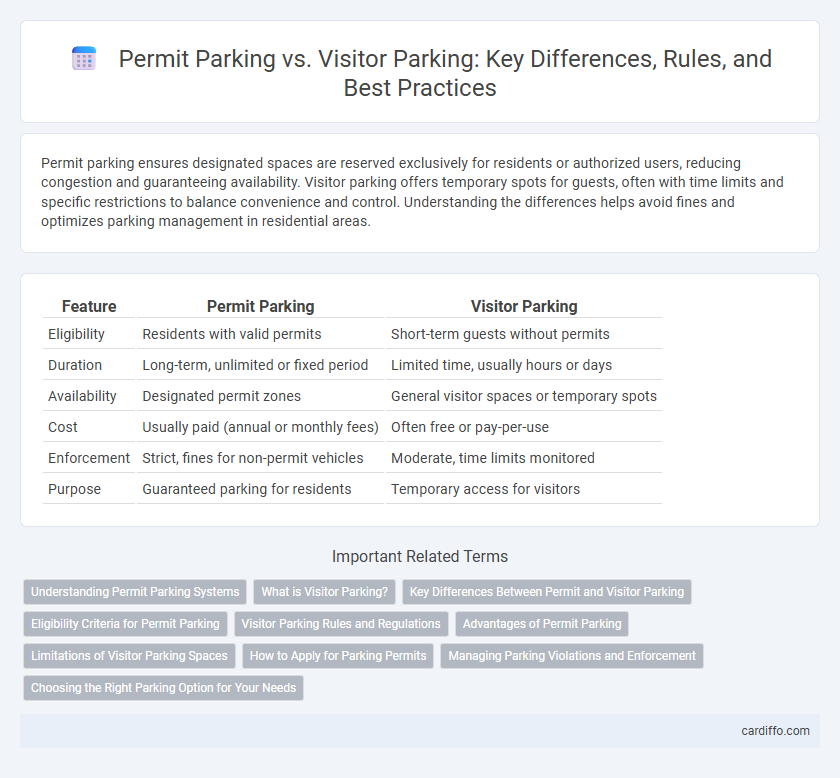Permit parking ensures designated spaces are reserved exclusively for residents or authorized users, reducing congestion and guaranteeing availability. Visitor parking offers temporary spots for guests, often with time limits and specific restrictions to balance convenience and control. Understanding the differences helps avoid fines and optimizes parking management in residential areas.
Table of Comparison
| Feature | Permit Parking | Visitor Parking |
|---|---|---|
| Eligibility | Residents with valid permits | Short-term guests without permits |
| Duration | Long-term, unlimited or fixed period | Limited time, usually hours or days |
| Availability | Designated permit zones | General visitor spaces or temporary spots |
| Cost | Usually paid (annual or monthly fees) | Often free or pay-per-use |
| Enforcement | Strict, fines for non-permit vehicles | Moderate, time limits monitored |
| Purpose | Guaranteed parking for residents | Temporary access for visitors |
Understanding Permit Parking Systems
Permit parking systems regulate access to designated parking areas by requiring vehicles to display a valid permit issued by local authorities or property management. These permits are typically tied to residents, employees, or long-term users, ensuring priority and availability in high-demand zones, whereas visitor parking offers temporary spots often limited by time or location. Understanding these distinctions helps enforce parking policies, reduce congestion, and improve overall community access and convenience.
What is Visitor Parking?
Visitor parking refers to designated parking spaces allocated specifically for guests and short-term visitors rather than regular permit holders. These spots often have time restrictions and are located in accessible areas to accommodate temporary parking needs without requiring a residential permit. Visitor parking helps manage parking availability and ensures convenience for non-resident visitors in residential or commercial zones.
Key Differences Between Permit and Visitor Parking
Permit parking requires a valid permit issued by the property management or local authority, allowing long-term or resident vehicle access, while visitor parking is designated for temporary use by guests without permits. Permit parking spots often have fixed allocations and enforcement times, ensuring reserved spaces for permit holders, whereas visitor parking is typically first-come, first-served and time-restricted to accommodate short-term stays. Key differences include eligibility criteria, duration limits, and enforcement policies that prioritize permit holders' consistent access over visitor convenience.
Eligibility Criteria for Permit Parking
Permit parking eligibility primarily targets residents within designated zones who provide proof of address and vehicle registration tied to the address. Criteria often require vehicles to be registered under the permit holder's name or immediate family members at the residence. Visitor parking, in contrast, typically allows temporary access without strict residency verification, facilitating short-term stays for guests.
Visitor Parking Rules and Regulations
Visitor parking regulations typically specify time limits, permit requirements, and designated areas to ensure availability for short-term use. These rules often restrict the duration visitors can park, such as limiting stays to a few hours or specific days, and may require displaying a temporary visitor permit. Enforcement measures include fines or towing for violations, maintaining fair access and preventing misuse of visitor parking spaces.
Advantages of Permit Parking
Permit parking offers guaranteed access to designated spaces, reducing the stress of searching for parking in high-demand areas. It enhances community security by restricting parking to authorized vehicles, minimizing the risk of unauthorized or long-term parking by outsiders. Permit systems also facilitate better enforcement and management, ensuring availability for residents and regular users while optimizing parking space utilization.
Limitations of Visitor Parking Spaces
Visitor parking spaces often have strict time limits, typically ranging from 30 minutes to a few hours, restricting long-term use. These spaces may require registration or permits for extended stays, limiting accessibility for spontaneous visitors. Unlike permit parking, visitor spots are usually fewer in number and located farther from the main entrances, reducing convenience and availability.
How to Apply for Parking Permits
To apply for parking permits, residents typically need to submit proof of residency, vehicle registration, and identification through their local municipality's parking office or online portal. Visitor parking permits often require a separate application or can be requested through the resident's permit account, with limitations on duration and frequency. Municipal websites provide specific instructions, eligibility criteria, and fee structures for both permit and visitor parking applications.
Managing Parking Violations and Enforcement
Permit parking ensures that only authorized vehicles can occupy designated spaces, simplifying the monitoring and enforcement of parking regulations. Visitor parking requires clear time limits and permit display rules to reduce unauthorized use and ensure availability for guests. Effective management involves regular patrols, automated ticketing systems, and clear signage to deter violations and streamline enforcement processes.
Choosing the Right Parking Option for Your Needs
Permit parking offers long-term, reserved spaces ideal for residents or employees requiring consistent access, while visitor parking provides temporary spots for guests with time-limited use designed to manage short stays efficiently. Selecting the right option depends on the frequency of parking needs and duration of stay, ensuring convenience and compliance with local regulations. Prioritize permit parking for daily access and visitor parking for occasional stops to optimize availability and reduce unauthorized use.
Permit parking vs visitor parking Infographic

 cardiffo.com
cardiffo.com